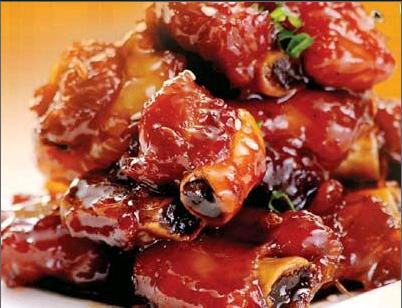Chemical Reaction Inside Pot
2014-11-27WangYanyan
Wang+Yanyan


When you are licking your chaps by various inviting gourmet, have you ever known what chemical reactions might happen to food and its materials in the wok? If you are able to apply chemical knowledge to cooking , you are likely to cook more delicious food.
The sweet and sour spare ribs is a dish enjoyed by most people. Among such three styles of cooking as Sichuan, Zhejiang and Shanghai type, the precise technique of the dish differs slightly, but ingredients like sugar, vinegar and cooking wine are required in the three types. The color and lustre, full-bodied meat smell, as well as sweet and sour flavor of the dish has a close tie with the chemical reaction between such ingredients and ribs.
Reaction Of
Sugar Browning
Reaction of caramelization happens to sweet and sour ribs in the oil. Sugar, especially monosaccharide with no amino compound, when heated over melting point( generally 140-170℃), because sugar undergoes dehydration and degradation and displays browning rection, which is called reaction of sugar browning, also called caramelization.
Sugar can generate two substances when it is heated in high temperature: one is dehydration outcome of sugar, namely caramel; the other is dissociation outcome, namely volatile substances like aldehyde and ketone, eventually forms dark matter after further condensation and polymerization. The aldehyde and ketone released by caramelization is one of the source of flavor, and the dark substance produced plays an important role in making sweet and sour ribs shiny brownish red.
Maillard Reaction
The other reaction that can add color and flavor to sweet and sour ribs is called Maillard reaction. The making of the ribs just meet the conditions that mailard reaction requests: the existence of sugar, amino compound and water. Maillard reaction, also called non-enzymatic browning reaction, was put forward by Frech chemist Maillard in 1912. The reaction, one non-enzymatic browning reaction widely applicable in food industry, is a reaction between carbonyl compound(reducing sugar) and amino compound(amino acid and protein), so it is also named amino-carbonyl reaction, which ultimately generates brown, even black macromolecule substance called melanoidins after complicated chemical process. The brown and strong flavor of the ribs, golden yellow of bread crust, bronzing of fried food and others, to a great extent, are the outcome of Maillard reaction.
Esterification reaction
Then attractive flavor of the ribs is only the result of the two above-mentioned reactions? The answer is no! there is a third reaction which is repercussion between ethyl alcohol of cooking wine and acetic acid of edible vinegar, also called flavor-producing reaction. Alcohol and carboxyl or mineral acid containing oxygen generates ester and water, such reaction is called esterification reaction.
Esterification reaction can fall into two categories: one is the reaction between carboxylic acid and alcohol; the other is carboxyl of inorganic oxyacid and alcohol. The interaction between cooking wine and vinegare belongs to the first category and it has such a reacting process: carboxyl in the molecule of carboxylic acid and hydrogen atom of hydroxy in alcoholic molecule works together to produce water, and the rest forms ester by interacting with each other, which is an important factor that makes sweet and sour ribs flavored. Various ester generated by esterification is characterized by its special fragrance, such as ethyl alcohol in white wine and citric acid of lemon juice can lead to esterification reaction, generating ethyl ester of citric acid which has a flavor of fresh fruits, besides, it also produces butyl acetate, isoamyl acetate, ethyl acetate and others, each with its own fragrance.
With Gelatinization
To Fry Crispy And Tasty
Potatoes Wires
It is believed that frying potatoes silk is familiar to most people , be it in sour sauce or sour and hot , the key factor of the making is to make it crisp, beause potato is rich in large starch, crisp or not having a close tie with gelatinization of starch. The reaction generally refers to starch is not soluble in water in normal temperature, but when water temperature is up to over 53℃, remarkable changes have taken place in its physical properties---an even pasty solution formed by splitting in high temperature. In frying the dish, we have to avoid both the gelatinization of starch, which can get crisp taste; the other thing we have to avoid is we could not prevent gelatinization of starch entirely, if with entire prevention of the reaction, the dish will be to hard and bad for the digestive absorption of starch in the body.
There a several factors that influences gelatinization during frying: the amout of starch, water content in the food, oil, degree of sour and others. In order to limit its gelatinization, we have to rinse the potato wires for a couple of times, reducing the content of starch. Before putting it into the pot, we should not pour less oil into the pot, this is because oil can interact with starch and prevent its gelatinization. It is better to add appropriate vinegar during cooking to adjust its degree of sour because the reduction of sour will accelerate gelatinization. The appropriate reduction of the value of PH is conducive to lower gelatinization, therefore, vinegar can restrain gelatinization and make it crisp and tasty.
Having said all of the above, you must feel that chemical phenomenon is everywhere in our daily life, and our own kitchen is a natural chemical laboratory. Let get started and try to cook more delicious food for our health!
